Question # 1
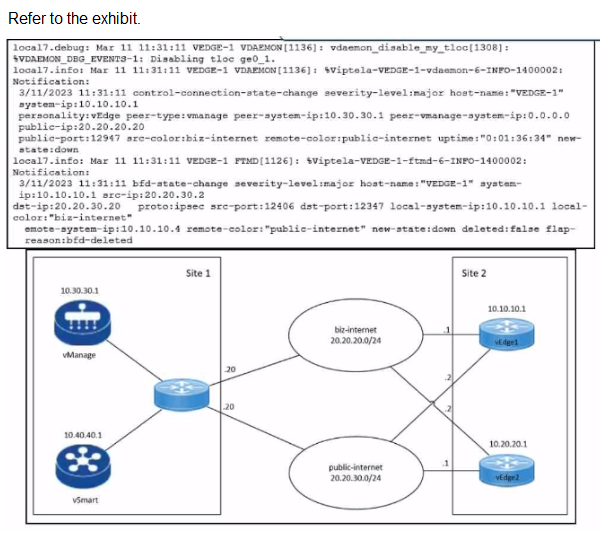
An engineer troubleshoots a Cisco SD-WAN connectivity issue
between an on-premises data center WAN Edge and a public cloud provider WAN Edge.
The engineer discovers that BFD is Dapping on vEdge1. What is the problem? |
| A. The remote Edge device BFD is down. | | B. The remote Edgedevice failed to respond BFD keepalives. | | C. The remote Edge device has a duplicate IP address | | D. The control plane deleted the BFD session |
B. The remote Edgedevice failed to respond BFD keepalives.
Explanation:
BFD (Bidirectional Forwarding Detection) is a protocol that detects failures in the overlay
tunnel between Cisco SD-WAN devices. BFD packets are sent and received periodically by
each device to check the liveliness and quality of the connection. If a device does not
receive a BFD packet from its peer within a specified timeout interval, it considers the peer
to be unreachable and reports a BFD down event. This event triggers a control connection
state change and a possible route change in the SD-WAN fabric.
In this scenario, the engineer discovers that BFD is flapping on vEdge1, which means that
the BFD session between vEdge1 and the remote Edge device is going up and down
repeatedly. This indicates a connectivity issue between the two devices, such as network
congestion, packet loss, or misconfiguration. The most likely cause of the problem is that the remote Edge device failed to respond BFD keepalives within the timeout interval, which
resulted in a BFD timeout event on vEdge1. This event caused vEdge1 to mark the remote
Edge device as down and notify the control plane. The control plane then tried to establish
a new BFD session with the remote Edge device, which may have succeeded or failed
depending on the network condition. This cycle of BFD session creation and deletion
caused the BFD flapping on vEdge1.
The other options are less likely to be the cause of the problem. Option A is incorrect
because if the remote Edge device BFD was down, vEdge1 would not receive any BFD
packets from it and would not flap. Option C is incorrect because if the remote Edge device
had a duplicate IP address, vEdge1 would not be able to establish a BFD session with it in
the first place. Option D is incorrect because the control plane does not delete the BFD
session unless there is a configuration change or a port-hop event on the
device.
Question # 2
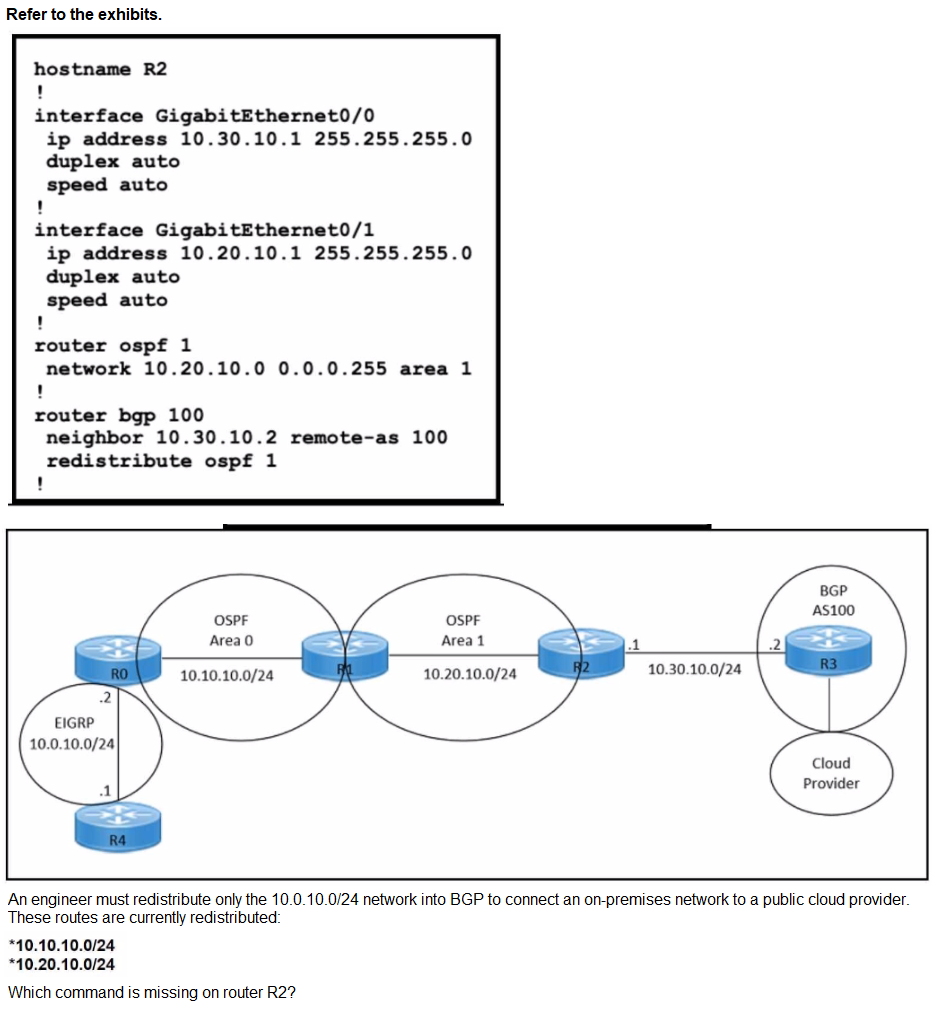 |
| A. neighbor 10.0.10.2 remote-as 100 | | B. redistribute ospf 1 match internal | | C. redistribute ospf 1 match external | | D. neighbor 10.0.10.0/24 remote-as 100 |
C. redistribute ospf 1 match external
Explanation:
The command redistribute ospf 1 match external is missing on router R2. This command is
needed to redistribute only the external OSPF routes into BGP. The external OSPF routes
are those that are learned from another routing protocol or redistributed into OSPF. In this
case, the 10.0.10.0/24 network is an external OSPF route, as it is redistributed from EIGRP
into OSPF on router R1. The other commands are either already present or not relevant for
this scenario.
Question # 3
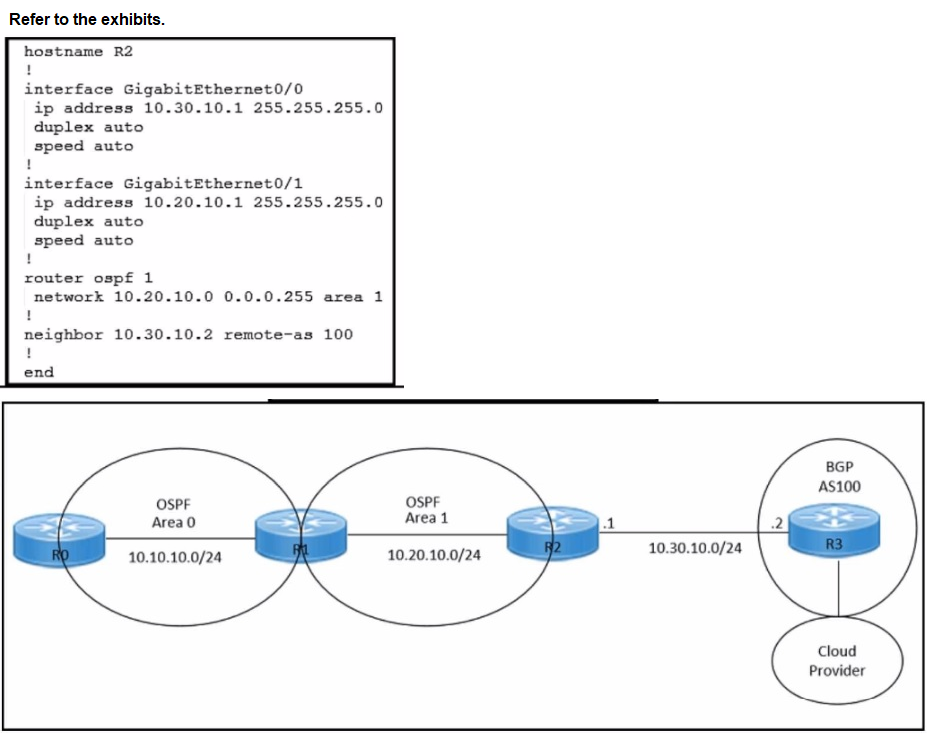
An engineer must redistribute OSPF internal routes into BGP to
connect an on-premises network to a cloud provider. Which two commands should the
engineer run on router R2? (Choose two.) |
| A. router bgp 100 | | B. redistribute bgp 100 | | C. router ospf 1 | | D. redistribute ospf 1 | | E. redistribute ospf 100 |
A. router bgp 100
D. redistribute ospf 1
Explanation: To redistribute OSPF internal routes into BGP for connecting an on-premises
network to a cloud provider, the engineer should run the commands “router bgp 100” and “redistribute ospf 1” on router R2. The command “router bgp 100” is used to create a BGP
routing process with AS number 100. The command “redistribute ospf 1” is used to
redistribute OSPF routes from process ID 1 into BGP. References: = I need to access the
specific content of Designing and Implementing Cloud Connectivity (ENCC) v1.0 from
Cisco’s official resources to provide exact references. However, I don’t have direct access
to external databases or resources, including the Cisco ENCC course materials. I
recommend referring to the ENCC course materials for the most accurate and detailed
information. Please note that this answer is based on general networking principles and
may not reflect the specific content of the ENCC course. Always refer to the official course
materials for the most accurate information.
Question # 4
| An engineer must configure an IPsec tunnel to the cloud VPN gateway. Which Two actions
send traffic into the tunnel? (Choose two.) |
| A. Configure access lists that match the interesting user traffic. | | B. Configure a static route | | C. Configure a local policy in Cisco vManage | | D. Configure an IPsec profile and match the remote peer IP address. | | E. Configure policy-based routing. |
A. Configure access lists that match the interesting user traffic.
E. Configure policy-based routing.
Explanation:
To send traffic into an IPsec tunnel to the cloud VPN gateway, the engineer must configure
two actions:
Configure access lists that match the interesting user traffic. This is the traffic that
needs to be encrypted and sent over the IPsec tunnel. The access lists are applied
to the crypto map that defines the IPsec parameters for the tunnel.
Configure policy-based routing (PBR). This is a technique that allows the engineer
to override the routing table and forward packets based on a defined policy. PBR
can be used to send specific traffic to the IPsec tunnel interface, regardless of the
destination IP address. This is useful when the cloud VPN gateway has a dynamic
IP address or when multiple cloud VPN gateways are available for load balancing
or redundancy.
References:
Designing and Implementing Cloud Connectivity (ENCC) v1.0, Module 3:
-
Implementing Cloud Connectivity, Lesson 3: Implementing IPsec VPNs to the
Cloud, Topic: Configuring IPsec VPNs on Cisco IOS XE Routers
-
Security for VPNs with IPsec Configuration Guide, Cisco IOS XE, Chapter:
Configuring IPsec VPNs, Topic: Configuring Crypto Maps
-
[Cisco IOS XE Gibraltar 16.12.x Feature Guide], Chapter: Policy-Based Routing,
Topic: Policy-Based Routing Overview
Question # 5
| An engineer must use Cisco vManage to configure an SLA class to specify the maximum
packet loss, packet latency, and jitter allowed on a connection. Drag and drop the steps
from the left onto the order on the right to complete the configuration. |

Question # 6
An engineer must configure a CLI add-on feature template in Cisco vManage for enhanced
policy-based routing (ePBR) for IPv4. These configurations were deleted:
- licensing config enable false
- licensing config privacy hostname true
- licensing config privacy version false
- licensing config utility utility-enable true
Drag and drop the steps from the left onto the order on the right to complete the
configuration.
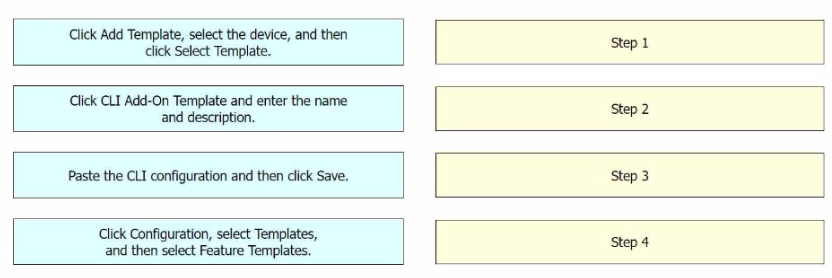 |
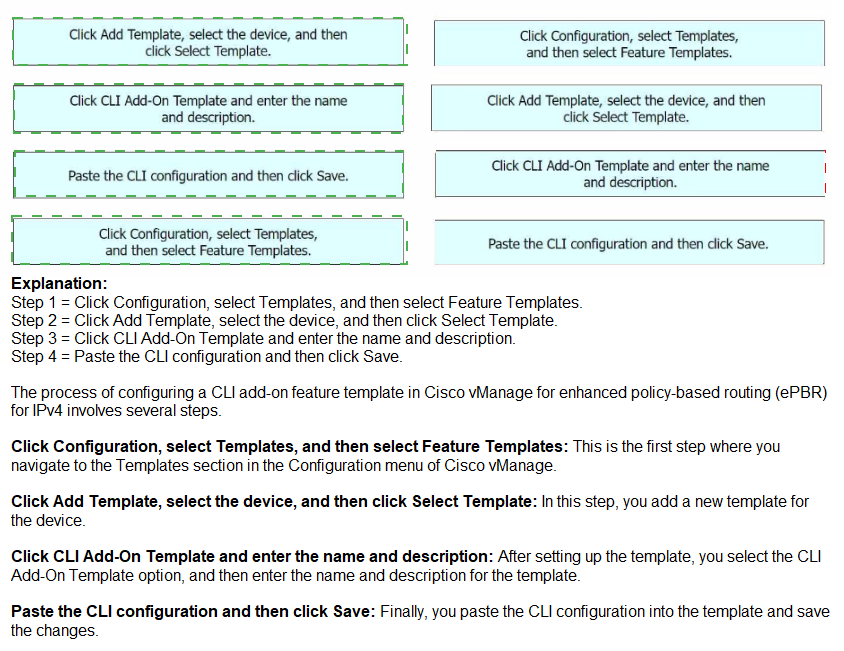
Question # 7
| An engineer signs in to Cisco vManage and needs to configure a custom application with a
Cisco SD-WAN centralized policy. Drag and drop the steps from the left onto the order on
the right to complete the configuration. |
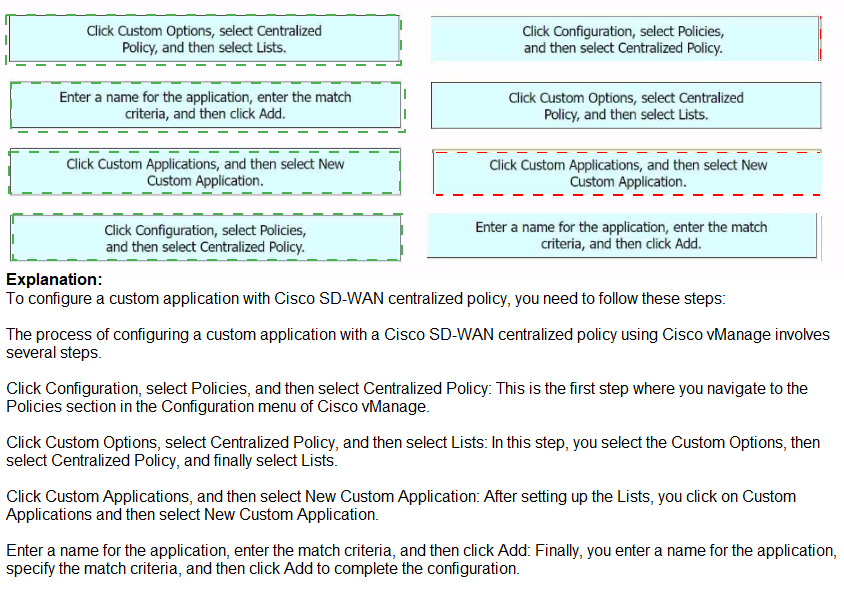
Question # 8

While troubleshooting an IPsec connection between a Cisco WAN edge router and an
Amazon Web Services (AWS) endpoint, a network engineer observes that the security
association status is active, but no traffic flows between the devices What is the problem? |
| A. wrong ISAKMP policy | | B. identity mismatch | | C. wrong encryption | | D. IKE version mismatch |
B. identity mismatch
Explanation: An identity mismatch occurs when the local and remote identities configured
on the IPsec peers do not match. This can prevent the establishment of an IPsec tunnel or
cause traffic to be dropped by the IPsec policy. In this case, the network engineer should
verify that the local and remote identities configured on the Cisco WAN edge router and the
AWS endpoint match the values expected by each peer. The identities can be an IP
address, a fully qualified domain name (FQDN), or a distinguished name (DN). The
identities are exchanged during the IKE phase 1 negotiation and are used to authenticate
the peers. If the identities do not match, the peers will reject the IKE proposal and the IPsec
tunnel will not be established or will be torn down.
Get 38 Designing and Implementing Cloud Connectivity (ENCC) questions Access in less then $0.12 per day.
Cisco Bundle 1:
1 Month PDF Access For All Cisco Exams with Updates
$200
$800
Buy Bundle 1
Cisco Bundle 2:
3 Months PDF Access For All Cisco Exams with Updates
$300
$1200
Buy Bundle 2
Cisco Bundle 3:
6 Months PDF Access For All Cisco Exams with Updates
$450
$1800
Buy Bundle 3
Cisco Bundle 4:
12 Months PDF Access For All Cisco Exams with Updates
$600
$2400
Buy Bundle 4
Disclaimer: Fair Usage Policy - Daily 5 Downloads
Designing and Implementing Cloud Connectivity (ENCC) Test Dumps
Exam Code: 300-440
Exam Name: Designing and Implementing Cloud Connectivity (ENCC)
- 90 Days Free Updates
- Cisco Experts Verified Answers
- Printable PDF File Format
- 300-440 Exam Passing Assurance
Get 100% Real 300-440 Exam Dumps With Verified Answers As Seen in the Real Exam. Designing and Implementing Cloud Connectivity (ENCC) Exam Questions are Updated Frequently and Reviewed by Industry TOP Experts for Passing CCNP Enterprise Exam Quickly and Hassle Free.
Cisco 300-440 Test Dumps
Struggling with Designing and Implementing Cloud Connectivity (ENCC) preparation? Get the edge you need! Our carefully created 300-440 test dumps give you the confidence to pass the exam. We offer:
1. Up-to-date CCNP Enterprise practice questions: Stay current with the latest exam content.
2. PDF and test engine formats: Choose the study tools that work best for you.
3. Realistic Cisco 300-440 practice exam: Simulate the real exam experience and boost your readiness.
Pass your CCNP Enterprise exam with ease. Try our study materials today!
Official ENCC exam info is available on Cisco website at https://www.cisco.com/site/us/en/learn/training-certifications/exams/encc.html
Prepare your CCNP Enterprise exam with confidence!We provide top-quality 300-440 exam dumps materials that are:
1. Accurate and up-to-date: Reflect the latest Cisco exam changes and ensure you are studying the right content.
2. Comprehensive Cover all exam topics so you do not need to rely on multiple sources.
3. Convenient formats: Choose between PDF files and online Designing and Implementing Cloud Connectivity (ENCC) practice questions for easy studying on any device.
Do not waste time on unreliable 300-440 practice test. Choose our proven CCNP Enterprise study materials and pass with flying colors. Try Dumps4free Designing and Implementing Cloud Connectivity (ENCC) 2024 material today!
-
Assurance
Designing and Implementing Cloud Connectivity (ENCC) practice exam has been updated to reflect the most recent questions from the Cisco 300-440 Exam.
-
Demo
Try before you buy! Get a free demo of our CCNP Enterprise exam dumps and see the quality for yourself. Need help? Chat with our support team.
-
Validity
Our Cisco 300-440 PDF contains expert-verified questions and answers, ensuring you're studying the most accurate and relevant material.
-
Success
Achieve 300-440 success! Our Designing and Implementing Cloud Connectivity (ENCC) exam questions give you the preparation edge.
If you have any question then contact our customer support at live chat or email us at support@dumps4free.com.
Questions People Ask About 300-440 Exam
300-440 ENCC (Enterprise Network Core Technologies) exam is a Cisco certification test that assesses a candidate's skills and knowledge necessary to implement core enterprise network technologies. It covers a range of topics including routing, switching, security, and automation.
Cisco certifications are structured across four levels: Entry, Associate, Professional, and Expert. These levels represent a progression from beginner to advanced expertise in various network and IT disciplines.
Best CCNP track depends on your career goals and interests. Popular tracks include CCNP Enterprise for network engineers, CCNP Security for security-focused professionals, and CCNP Data Center for those interested in managing data center technologies.
CCNP Enterprise ENCC 300-440 exam evaluates a candidate's expertise by testing their ability to configure, manage, and troubleshoot enterprise network core technologies. It emphasizes real-world scenarios and practical knowledge of network solutions.
Recommended study resources for the Cisco ENCC 300-440 exam include the official Cisco learning materials, training courses, dumps4free 300-440 practice test, and study groups.
|

